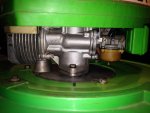Teds
Active Member
- Joined
- Jan 14, 2017
- Threads
- 2
- Messages
- 82
I rebuilt this engine over the winter, replacing the utility modular carburetor among other things, with a new reed plate and rebuilt a used D600 metal carburetor. It was dirty with old gummed fuel but cleaned up nicely. I replaced the needle and seat on general principles. All the internal passages are clear.
In this picture the governor lever hadn't been adjusted yet so throttle arm points to the 11 o'clock position. It now runs great at 2800 on low and 3280 RPM "normal". I don't want to run it again till summer when I can get it under load in the grass (if I try to mow the snow, the neighbors are gonna talk) so the rings will seat.
But this altitude needle adjust business. The manual says to turn in clockwise from 2 turns out till it starts to "hunt" or slow down. I didn't really notice this, if anything the RPM increased and it ran smoother. On automotive carbs idle mixture screws are leaned out for highest engine manifold vacuum, or RPM. But this is a 2 stroke, so I don't know. It's not super critical, but I like things to be set accurately enough. It did restart easily without priming.
Should I adjust the needle for highest RPM or, richen it to run a little rough? I've heard people say "till it 4 strokes" but I don't know what that means. Thanks for any help.

In this picture the governor lever hadn't been adjusted yet so throttle arm points to the 11 o'clock position. It now runs great at 2800 on low and 3280 RPM "normal". I don't want to run it again till summer when I can get it under load in the grass (if I try to mow the snow, the neighbors are gonna talk) so the rings will seat.
But this altitude needle adjust business. The manual says to turn in clockwise from 2 turns out till it starts to "hunt" or slow down. I didn't really notice this, if anything the RPM increased and it ran smoother. On automotive carbs idle mixture screws are leaned out for highest engine manifold vacuum, or RPM. But this is a 2 stroke, so I don't know. It's not super critical, but I like things to be set accurately enough. It did restart easily without priming.
Should I adjust the needle for highest RPM or, richen it to run a little rough? I've heard people say "till it 4 strokes" but I don't know what that means. Thanks for any help.


